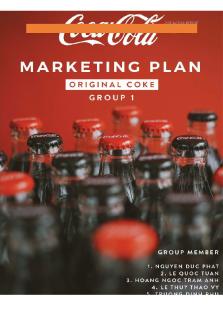Cola War - Case notes PDF

| Title | Cola War - Case notes |
|---|---|
| Course | Business Policy: Strategic Management |
| Institution | McMaster University |
| Pages | 2 |
| File Size | 69.5 KB |
| File Type | |
| Total Downloads | 64 |
| Total Views | 149 |
Summary
Case notes...
Description
Case 2: Cola Wars Conduct a Porter’s 5 forces analysis on the industry. Threats to Entry:
Bottling Network: Both Coke and PepsiCo have franchisee agreements with their existing bottlers who have rights in a certain geographic area in perpetuity. The other approach to try and build their bottling plants would be very expensive. Each concentrate manufacturing plant would cost from $50 million dollars to $100 million. And each bottling and canning line costing from $4 million to $10 million. Advertising Spend: Every percentage of market share for advertising is about 15 million dollars in 2009. Brand recognition / Customer Loyalty: Coke and Pepsi have a long history of marketing which has earned them brand loyalty with customers worldwide. Retail Distribution Economics of scale; You need a large amount of sales to make profits, because the profit margin is too low. Scale of economics for advertising; coke Suppliers:
Commodity Ingredients: Most of the raw materials needed to produce concentrate are basic commodities like Color, flavor, caffeine or additives, sugar, packaging. The producers of these products have no power over the pricing hence the suppliers in this industry are weak. Buyers:
Mass merchandisers (16.7%) Convenience Stores and gas stations (10.8%) Fountain outlets (23.1%) Vending machine (12.5%) Super Markets (29.1%) Substitutes: Large numbers of substitutes like water, beer, coffee, juices etc are available to the end consumers but this is balanced by concentrate providers by huge marketing and brand loyalty. Rivalry: The Concentrate Producer industry can be described as a Duopoly with Pepsi(29.9%) and Coke(41.9%) as the competing firms. The market share of the rest is too small and insignificant to cause any influence in this industry. Dr.Pepper (16.4%)
Why, historically, has the soft drink industry been so profitable?
Due to the strategic decisions Not a lot of capital investment Raw materials are basic commodities Efficient machinery Effective marketing and advertising Supplier negotiation power Low threat of entry Huge market share of top brands Worldwide brand, and everyone can easily acquire due to the variety of distribution channels.
Compare the economics of the concentrate business to that of the bottling business: Why is the profitability so different?
There’s barriers to protect market share It is difficult to search good substitute for bottlers Bottlers cannot easily switch to similar product due to exclusivity Concentrate business have taken majority market share however bottlers have competitors. Concentrate producers have lower percentage of cost of goods sold and have no selling&delivery expense compare to bottler.
How has the competition between Coke and Pepsi affected the industry’s profits?
Competition has led to mass marketing Price wars Lower prices for more market share Research in demographics and marketing Productivity is effected and has lowered profit margin of industry due to price wars
How can Coke and Pepsi sustain their profits in the wake of flattening demand and the growing popularity of non-CSDs?
the structure has been consistent for a very long time? Technology is not a threat to this industry Brand loyalty has come a long way for Coke and Pepsi Globalization has provided even more market share New products, new acquisitions, etc. Adapt new technology to lower costs, use cheaper alternative ingredients. Increase brand loyalty by having some special events, (I remember a few years back, you can put your names on a cola can)...
Similar Free PDFs

Cola War - Case notes
- 2 Pages

COCA-COLA CASE STUDY
- 13 Pages

Coca cola case study
- 2 Pages

COCA COLA CASE Study
- 5 Pages

Voice War - Case Summary
- 3 Pages

Coca Cola Company Case Study
- 4 Pages

Case 4 - Cola Wars - Case Study
- 2 Pages

History Cold War Notes
- 20 Pages

Cold war revision notes
- 4 Pages

CASE Study Analyis ON Pepsi COLA
- 8 Pages

War of 1812 Quiz notes
- 3 Pages

Cold War - Lecture notes 3
- 2 Pages

Causes of Pacific War Notes
- 7 Pages
Popular Institutions
- Tinajero National High School - Annex
- Politeknik Caltex Riau
- Yokohama City University
- SGT University
- University of Al-Qadisiyah
- Divine Word College of Vigan
- Techniek College Rotterdam
- Universidade de Santiago
- Universiti Teknologi MARA Cawangan Johor Kampus Pasir Gudang
- Poltekkes Kemenkes Yogyakarta
- Baguio City National High School
- Colegio san marcos
- preparatoria uno
- Centro de Bachillerato Tecnológico Industrial y de Servicios No. 107
- Dalian Maritime University
- Quang Trung Secondary School
- Colegio Tecnológico en Informática
- Corporación Regional de Educación Superior
- Grupo CEDVA
- Dar Al Uloom University
- Centro de Estudios Preuniversitarios de la Universidad Nacional de Ingeniería
- 上智大学
- Aakash International School, Nuna Majara
- San Felipe Neri Catholic School
- Kang Chiao International School - New Taipei City
- Misamis Occidental National High School
- Institución Educativa Escuela Normal Juan Ladrilleros
- Kolehiyo ng Pantukan
- Batanes State College
- Instituto Continental
- Sekolah Menengah Kejuruan Kesehatan Kaltara (Tarakan)
- Colegio de La Inmaculada Concepcion - Cebu


